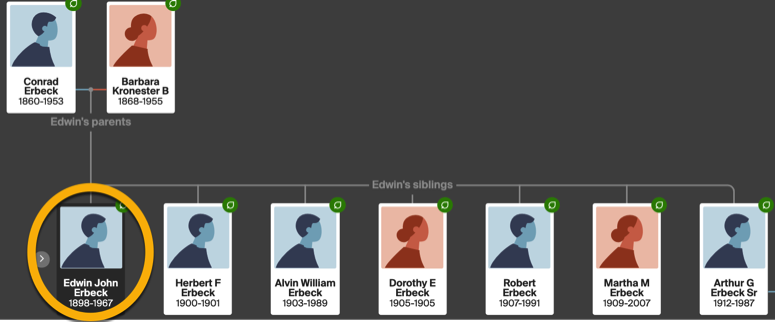
FAMILIES D-H: ERBECK ~ Edwin Erbeck
Five decades of U.S. federal census records (from 1900 to 1950) indicate that the Conrad Erbeck and his immediate family lived in Hamilton, Ohio - on North 5th street and North Shuler Avenue.
1860-Conrad Erbeck born
1897 - Conrad Erbeck married Barbara Bender
1898 - Edwin Erbeck born, son of Conrad and Barbara (Bender) Erbeck
1900 - Conrad Erbeck federal census report
1910 - Conrad Erbeck federal census report
1918 - Edwin Erbeck WWI registration card
1920 - Conrad Erbeck federal census report
1929 - Conrad Erbeck fought divorce request
1930 - Conrad Erbeck federal census report
1932 - Conrad Erbeck won dismissal of divorce
1940 - Conrad Erbeck federal census report
1942 - Edwin Erbeck WWII draft card
*1944 - 137.041 Milford Twp. acres transferred from Elias Carpenter to Conrad Erbeck et al
1949 - Conrad Erbeck’s sister, Anna, died
1950 - Conrad Erbeck federal census report
1950 - Edwin Erbeck federal census report
1953 - Conrad Erbeck gravesite noted
1958 - Hogs stolen from the Edwin Erbeck farm
1967 - Edwin Erbeck death recorded
1967 - Edwin Erbeck obituary noted, with home address
1967 - Edwin Erbeck Social Security Death Index
*1968 (Jan 11) - 137.041 Milford Twp. acres transferred from Edwin Erbeck dec;d to Martha Herold et al
*1968 (May 9) - 137.041 Milford Twp. acres transferred from Martha Herold et al to Robt. Walther et al
Edwin John Erbeck (1898-1967) is the Darrtown pioneer for the Erbeck branch of the Darrtown Family Tree.

The image at the right was taken from the Darrtown Family Tree at Ancestry.com.
As noted, Edwin John Erbeck was the oldest of seven children born to Conrad and Barbara (Kronester-Bender) Erbeck.
The following link shows how the Erbeck farm was accessed by a lane that ran north about 1/8th of a mile, from a point opposite the old brick school house (named Milford Township school house #11).
The location of the 137.041 acres that Edwin's father, Conrad Erbeck, bought in 1944 is clarified in a 1955 Milford Township map (see link below).
No records have been found to indicate that Conrad Erbeck ever lived on the Scott Road property.
However, items displayed in the following "Erbeck Chronology" confirm that Conrad's oldest son, Edwin, lived at the Scott Road residence, thus earning Edwin the Darrtown pioneer designation.

The following quotation, excerpted from the Memoirs of Miami Valley about the Bender family of Hamilton, Ohio, confirms that Edwin Erbeck was a farmer: “The second adopted child of Mr. and Mrs. Bender is Barbara, who married Conrad Erbeck, a carpenter of Hamilton, Ohio, and their children are as follows: Edwin, who is a farmer; Alvin, who is a carpenter; Robert, Martha and Arthur, attending school.”
The three items marked with an asterisk and bold font in the "Erbeck Chronology" above are taken from Milford Twp. Section 27 property records - courtesy of the Butler County Recorder's website. Click the following link to see Section 27 property transactions.

Instructions for accessing Butler County property records onine are provided in this website's research section.
The link below shows an image of Scott Road at the point where the lane to the Erbeck farm began.
The links in this Erbek chronology reveal the sources of the chronological events.
The connection between Darrtown and the Erbeck family occurred in 1944, when, according to Butler County property records, Conrad Erbeck bought 137.041 acres of Milford Township land - located at 2290 Scott Road.
Over the years, the farm described on this page as the Erbeck farm had multiple owners. For example, the Kepplers owned the property at 2290 Scott Road, in the early 1900s.
The Keppler family page includes information about the farm's isolated location.
See details at the Keppler family page.
Some say that the farm was so secluded that it served as a "hideout" for persons seeking privacy from prying eyes.

